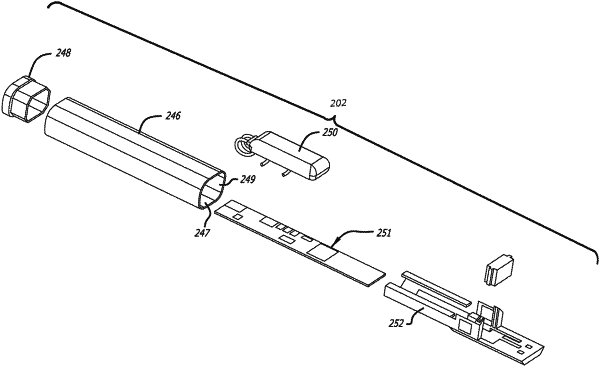| CPC A61M 15/001 (2014.02) [A61M 15/002 (2014.02); A61M 15/0085 (2013.01); B05B 12/08 (2013.01); B05B 17/0646 (2013.01); B05B 17/0661 (2013.01); B05B 17/0669 (2013.01); B05B 17/0684 (2013.01); A61M 15/06 (2013.01); A61M 2205/3368 (2013.01); A61M 2205/3375 (2013.01); A61M 2205/8206 (2013.01)] | 13 Claims |

|
1. A mist generator device for use with a driver device, the mist generator device comprising;
a mist generator housing which is elongate and has a bottom end, an opposite top end, and a longitudinal axis passing through the ends, an air inlet port proximate the bottom end and a mist outlet port proximate the top end;
a liquid chamber provided within the mist generator housing, the liquid chamber configured to contain a liquid to be atomized;
a sonication chamber provided within the mist generator housing;
a capillary element extending between the liquid chamber and the sonication chamber such that a first portion of the capillary element is within the liquid chamber and a second portion of the capillary element is within the sonication chamber;
an ultrasonic transducer having a generally planar atomization surface which is provided within the sonication chamber, the ultrasonic transducer being mounted within the mist generator housing, wherein part of the second portion of the capillary element is positioned over at least part of the atomization surface, and wherein the ultrasonic transducer is configured to vibrate the atomization surface to atomize a liquid carried by the second portion of the capillary element to generate the mist comprising the atomized liquid and air within the sonication chamber;
an airflow channel within the mist generator housing which provides an air flow path between the air inlet port, the sonication chamber and the air outlet port such that a user drawing on the mist outlet port draws air through the inlet port, through the sonication chamber and out through the mist outlet port, the airflow channel is configured to change the direction of a flow of air along the air flow path as the flow of air passes into the sonication chamber, wherein the airflow channel comprises;
a first portion initiating at the air inlet port that is substantially parallel to the longitudinal axis of the housing and continuing to a second portion of the airflow channel in communication with the sonication chamber,
the second portion of the airflow channel is substantially perpendicular to the longitudinal axis of the housing and has a central longitudinal axis substantially perpendicular to the atomisation surface of the ultrasonic transducer such that the direction of the flow of air is substantially perpendicular to the plane of the atomisation surface of the ultrasonic transducer,
a third portion of the airflow channel is substantially parallel to the longitudinal axis of the housing and continues from the sonication chamber toward the air outlet opening with the mist generated in the sonication chamber being carried by the air out through the mist outlet port for inhalation by the user; and
an identification circuitry which is provided with the mist generator housing to identify the mist generator device, the identification circuitry comprising:
a one-time programmable integrated circuit (OTP IC) having a memory which stores a unique identifier for the mist generator device, the OTP IC comprising a digital core which includes a cryptographic authenticator, and
an electrical connection which provides an electronic interface for communication with the OTP IC and the driver device, wherein the memory of the OTP IC stores instructions executed by a processor to perform the following Public Key Infrastructure (PKI) procedure in order to authenticate the OTP IC when coupled to the driver device, the OTP IC is programmed to:
(1) Verify Signer Manufacturing Public Key: in response to a request from the driver device, the OTP IC sends to the driver device a Manufacturing Public key and a Manufacturing Certificate for verification b the driver device of the Manufacturing certificate with an Authority Public key;
(2) Verify Device Public Key: if the verification is successful, in response to a request from the driver device the OTP IC sends to the driver device the Device Public key and a Device Certificate for verification by the driver device of the Device Certificate with the Manufacturing Public key;
(3) Challenge—Response: if the verification of the Device Public Key is successful, the OTP IC receives from the driver device a random number challenge the cryptographic authenticator of the OTP IC signs the random number challenge with a Device Private key; and
(4) The OTP IC sends a signature to the driver device for verification using the Device Public key;
wherein if all of the steps (1) through (4) of the authentication procedure are completed successfully then the OTP IC is successfully authenticated for use with the driver device,
wherein, if any of the steps (1) through (4) of the authentication procedure fail then the OTP IC is not authenticated for use with the driver device and use of the mist generator device incorporating the OTP IC is restricted or prevented.
|